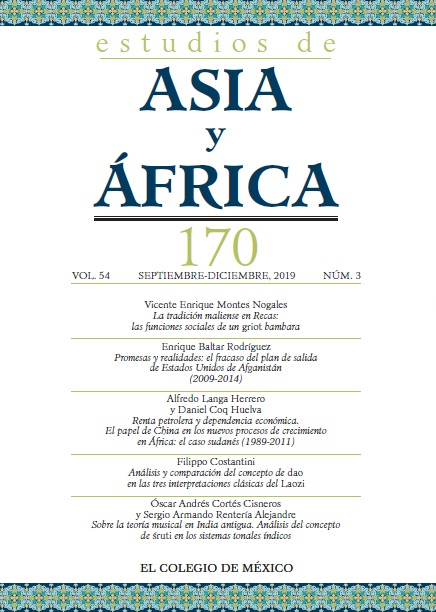Resumen
Se analiza y compara el concepto de dao en los tres comentarios más influyentes del Laozi, y, en particular, cómo las distintas lecturas del dao en los tres textos se relacionan con diferentes épocas históricas, tradiciones, objetivos y autores de los comentarios. Por ejemplo, la tradición de la escuela Huang-Lao, con su interés en teorías cosmológicas y prácticas de autocultivo, impregna el comentario Heshang gong y su visión del dao como principio cósmico accesible y cognoscible. Por otra parte, en el Xiang Er, la institución religiosa de los Maestros Celestiales plasma el Laozi como texto sagrado y el dao como una divinidad con preceptos claros e inteligibles. A su vez, la relativa libertad interpretativa de Wang Bi, desprovista de influencias exegéticas ortodoxas, junto con la búsqueda de una coherencia interna en el texto, genera un comentario totalmente distinto de la tradición interpretativa anterior. El Laozi se convierte en manual de sabiduría que revela el dao como fundamento lógico del mundo.Referencias
Ames, R. T. (1994). The art of rulership: A study of ancient Chinese political thought. Albany, NY: State University of New York Press.
Bokenkamp, S. R. y Nickerson, P. S. (1997). Early Daoist scriptures. Berkeley, CA: University of California Press.
Boltz, W. G. (1982). The religious and philosophical significance of the ‘Hsiang erh’ Lao tzu 相爾老子 in the light of the Ma-wang-tui silk manuscripts. Bulletin of the School of Oriental and African Studies, 45(1), 95-117. https://dx.doi.org/10.1017/S0041977X00054380
Chan, A. K. L. (1991). Two visions of the way: A study of the Wang Pi and the Ho-shang Kung commentaries on the Lao-tzu. Albany, NY: State University of New York Press.
Chang, E. Y. T. (2001). The aesthetics of Wu: Wang Bi’s ontological paradigm and the transformation of Chinese aesthetics (Disertación de doctorado). University of California, San Diego.
Henricks, R. (Trad.). (1989). Lao-Tzu Te-Tao Ching: A new translation based on the recently discovered Ma-wang-tui texts. Nueva York, NY: Ballantine Books.
Lin, P. J. (Trad.). (1977). A translation of Lao Tzu’s Tao Te Ching and Wang Pi’s Commentary. Ann Arbor, MI: The University of Michigan.
Liu Q. 刘清章. (2015). Heshang gong zhangju pingzhu 河上公章句评注 [Anotaciones sobre el comentario de Heshang gong]. Beijing: Zongjiao wenhua chubanshe.
Lynn, R. J. (2015). Wang Bi and Xuanxue. En X. Liu (Ed.), Dao companion to Daoist philosophy (Vol. 6, pp. 369-395). Dordrecht: Springer. https://dx.doi.org/10.1007/978-90-481-2927-0_16
Michael, T. (2015). In the shadows of the Dao: Laozi, the sage, and the Daodejing. Albany, NY: State University of New York Press.
Puett, M. (2004). Forming spirits for the way: The cosmology of the Xiang’er commentary to the Laozi. Journal of Chinese Religions, 32(1), 1-27. https://dx.doi.org/10.1179/073776904804760020
Rao Z. 饒宗頤. (2015). Laozi Xiang Er xiaozheng 老子想爾校証 [Recopilación del comentario Xiang Er del Laozi]. Shanghái: Zhonghua Shuju.
Robinet, I. (1981). Historie du taoïsme. Des origines au XIVE siècle. París: Cerf.
Robinet, I. (1998). Later commentaries: Textual polysemy and syncretistic interpretations. En L. Kohn y M. LaFargue (Eds.), Lao-Tzu and the Tao-Te-Ching (pp. 119-142). Albany, NY: State University of New York Press.
Tadd, M. A. (2002). Alternatives to monism and dualism: Seeking yang substance with yin mode in Heshanggong’s commentary on the Daodejing (Disertación de doctorado). Universidad de Boston, Massachusetts.
Wagner, R. G. (1986). Wang Bi: “The structure of the Laozi’s pointers” (Laozi weizhi lilüe). T’oung Pao, 72(1), 92-129. https:// dx.doi.org/10.1163/156853286X00114
Wagner, R. G. (2000). The craft of a Chinese commentator: Wang Bi on the Laozi. Albany, NY: State University of New York Press.
Wagner, R. G. (2003a). Language, ontology, and political philosophy in China: Wang Bi’s scholarly exploration of the dark (Xuanxue). Albany, NY: State University of New York Press.
Wagner, R. G. (2003b). A Chinese reading of the Daodejing: Wang Bi’s Commentary on the Laozi with critical text and translation. Albany, NY: State University of New York Press.
Esta obra está bajo una licencia internacional Creative Commons Atribución-NoComercial-SinDerivadas 4.0.
Derechos de autor 2022 Estudios de Asia y África


